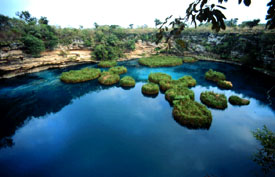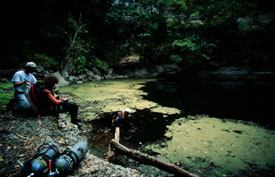PROJECT ZACATÓN — THE CENOTES OF EL RANCHO AZUFROSA
Located at the base of the small and rugged coastal mountain range known as the Sierras de Tamaulipas, a system of five cenotes [sink holes] of world class magnitude has been the focal point of the work done by the Proyecto de Buceo Espeleologico since 1989. The cenotes are filled with highly mineralized, thermally active waters with an average temperature exceeding 90°F [32 °C]. Zacatón, the best known of the sink holes, is the site of the men and women's world record depth dives made by Jim Bowden, beyond 925 feet [282 meters] in April, 1994, and 554 feet [169 meters] by Ann Kristovich, in September, 1993. These dives were made with tri-mixtures of helium, nitrogen, and oxygen, using open circuit scuba. The record setting dives required extensive decompression. Customized tables were prepared by the divers using Dr. X, software designed by team member Sheck Exley.
The cenotes La Pilita and Caracól, are physically adjacent to Zacatón and give the impression of being hydrologically linked. They are of similar temperature and fluctuate with seasonal rains as Zacatón. The exuberant expression of mineral clouds in Zacatón is reflected in these two systems as well. Bowden, Kristovich, and Stockton have explored the depths of these smaller cenotes and have located ongoing passage. The challenge in pushing these passages comes from the extreme depth, for La Pilita is greater than 358 feet [109 meters], and Caracól has been explored to a depth of 256 feet [78 meters]. Mixed gas technology will provide the tools needed by the team to pursue their goal of linking Zacatón, Caracól, and La Pilita.
 |
 |